Kopnin N.B. Theory of Nonequilibrium Superconductivity
Подождите немного. Документ загружается.

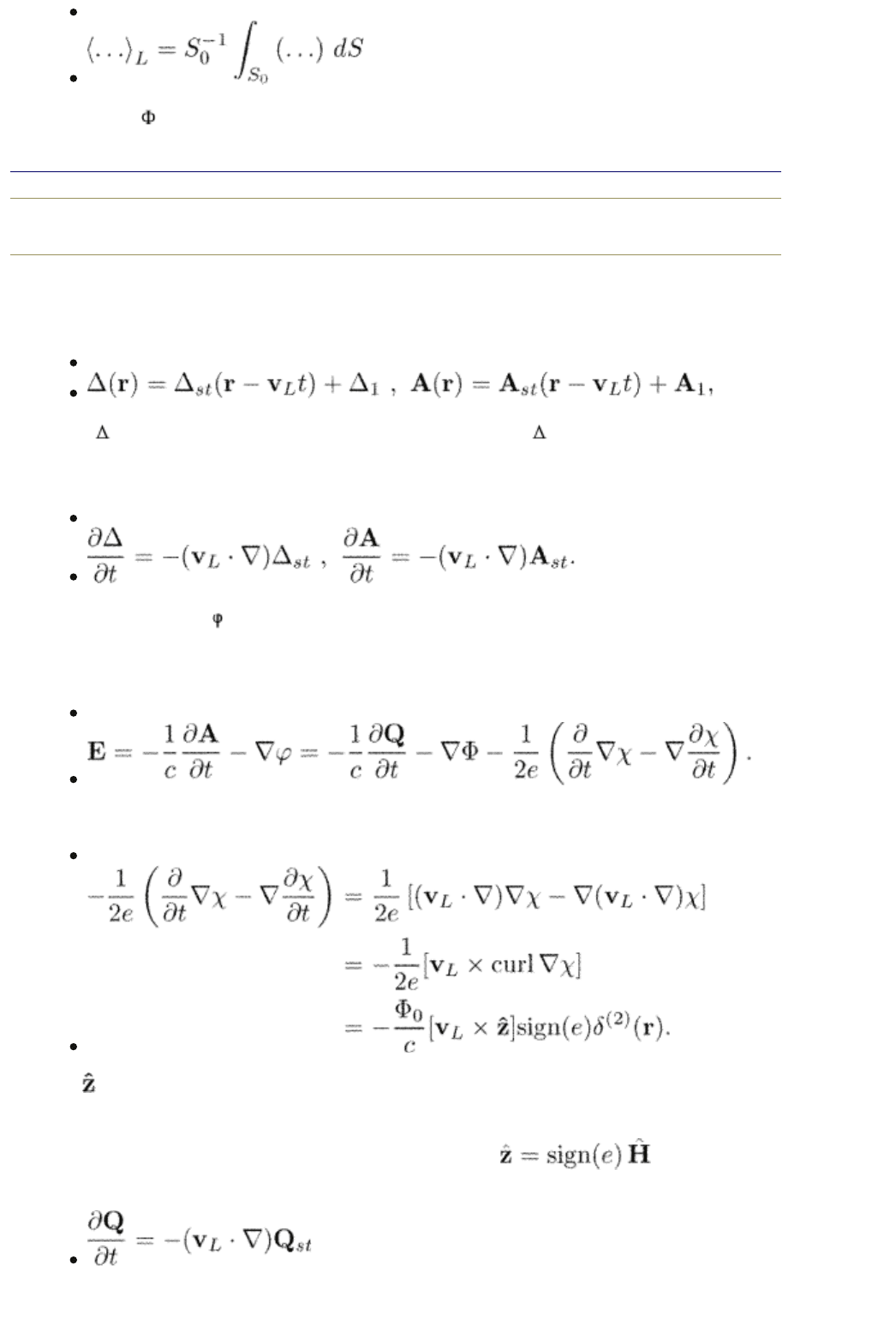
(12.6)
where S
0
=
0
/B is the area occupied by each vortex.
end p.234
All the values in eqn (12.4) can easily be calculated if the vortex velocity v
L
is
small. To calculate the time-derivative of the order parameter and of the vector
potential we note that, for a small vortex velocity,
(12.7)
where
st
and A
st
are the values for a static vortex, and
1
and A
1
are small
corrections. Therefore, within the main terms in the vortex velocity v
L
, we can
write
(12.8)
The scalar potential is to be found from eqn (1.80). For small v
L
it contains only
the static vortex order parameter.
Let us calculate the average electric field. The local electric field is
(12.9)
The last term here is nonzero for a moving vortex. Indeed,
(12.10)
Here is the unit vector along the vortex axis in the positive direction of its
circulation. The vortex circulation is determined by the sense of the phase
increment, it coincides with the magnetic field direction for positive charge of
carriers and is antiparallel to it for negative carriers:
, see
Section 1.1.2. We now average eqn (12.9) over the vortex array. Since
PRINTED FROM OXFORD SCHOLARSHIP ONLINE (www.oxfordscholarship.com)
© Copyright Oxford University Press, 2003-2010. All Rights Reserved
Oxford Scholarship Online: Theory of Nonequilibrium Supe... http://www.oxfordscholarship.com/oso/private/content/phy...
第6页 共7页 2010-8-8 16:01
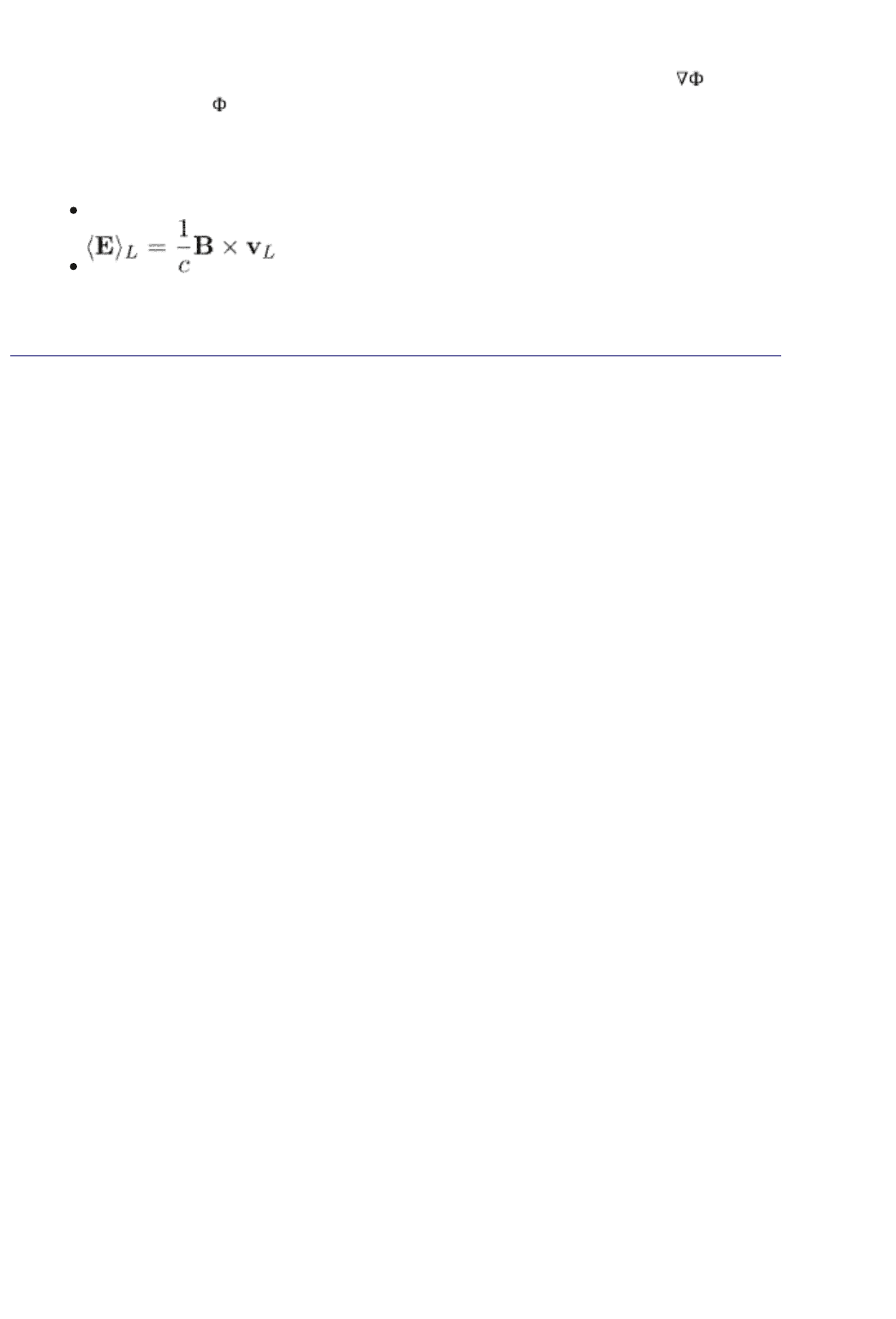
the average of this term vanishes because the gauge-invariant vector potential
Q
st
is a bounded oscillating function (periodic for a periodic vortex array). Its
value at the boundary of a region occupied by each vortex, i.e., at the boundary
of the vortex unit cell is zero, see eqn (1.40) on page 11. The average of
vanishes, too, since is also a bounded oscillating function periodic for a regular
vortex lattice. It turns to zero at the boundary of the vortex unit cell because of
the Josephson relation, eqn (11.49). The only term which survives is the last
term in eqn (12.9). Equation (12.10) gives
(12.11)
which is the Faraday’s law.
end p.235
Top
Privacy Policy and Legal Notice © Oxford University Press, 2003-2010. All rights reserved.
Oxford Scholarship Online: Theory of Nonequilibrium Supe... http://www.oxfordscholarship.com/oso/private/content/phy...
第7页 共7页 2010-8-8 16:01
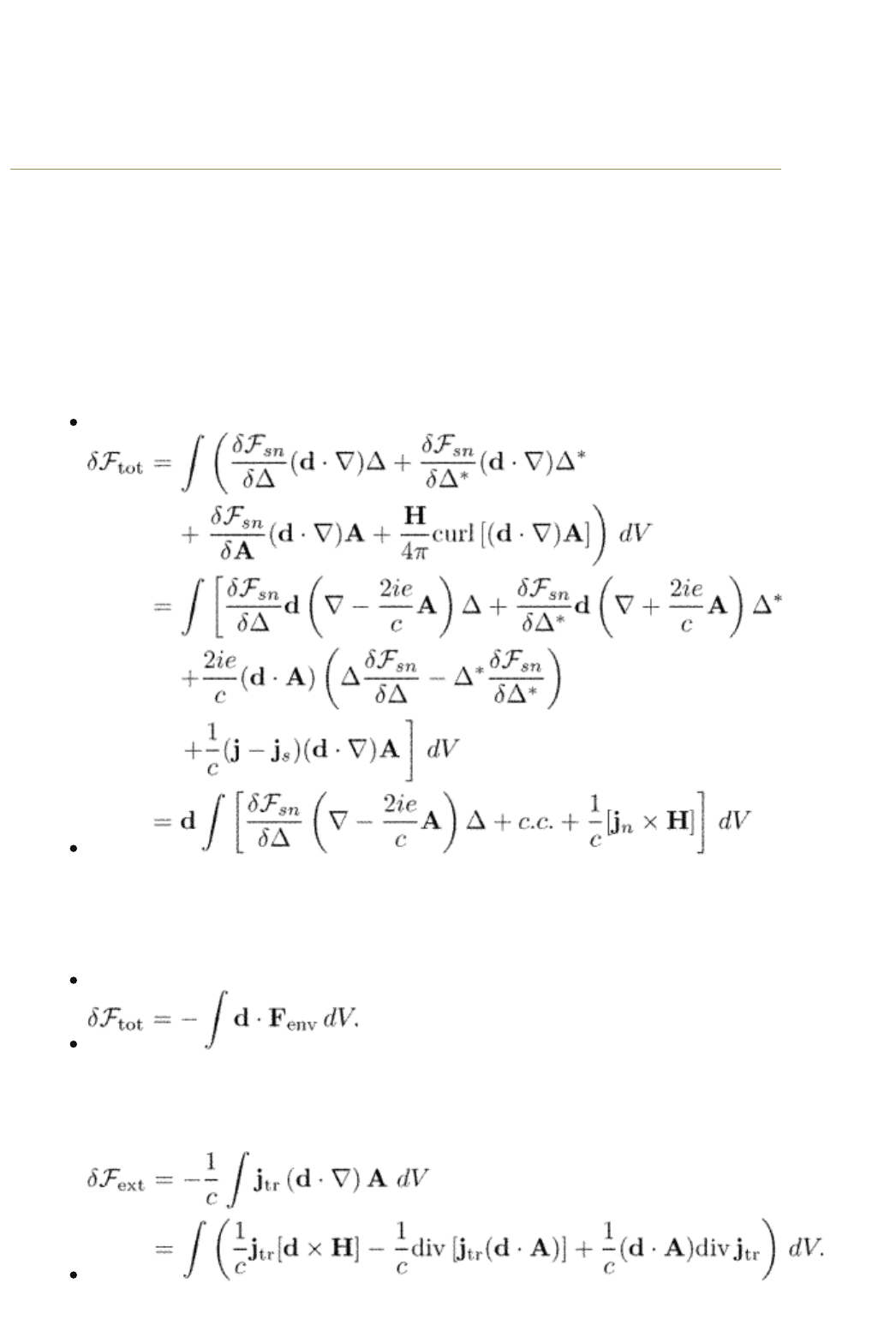
Now we can calculate W. It is more instructive, however, to consider another
useful relation which follows from the TDGL equations. It is expression for the
force which acts on a moving vortex.
12.4 Force balance
Let us shift our vortex by a small arbitrary constant vector d and calculate the
variation of the free energy caused by such a displacement. During the derivation
we neglect surface contributions. We have
(12.12)
where we use eqn (1.76) and the charge neutrality divj = 0.
Variation of the free energy determines the force which acts on a moving vortex
from the environment
(12.13)
It should be balanced by external Lorentz force due to the transport current. To
include this force we add the free energy due to the transport current which is
supplied by the external source. Its variation due to the vortex displacement is
Kopnin, Nikolai, Senior Scientist, Low Temperature Laboratory, Helsinki University of
Technology, and L.D. Landau Institute for Theoretical Physics, Moscow
Theory of Nonequilibrium Superconductivity
Print ISBN 9780198507888, 2001
pp. [236]-[240]
Oxford Scholarship Online: Theory of Nonequilibrium Supe... http://www.oxfordscholarship.com/oso/private/content/phy...
第1页 共6页 2010-8-8 16:01
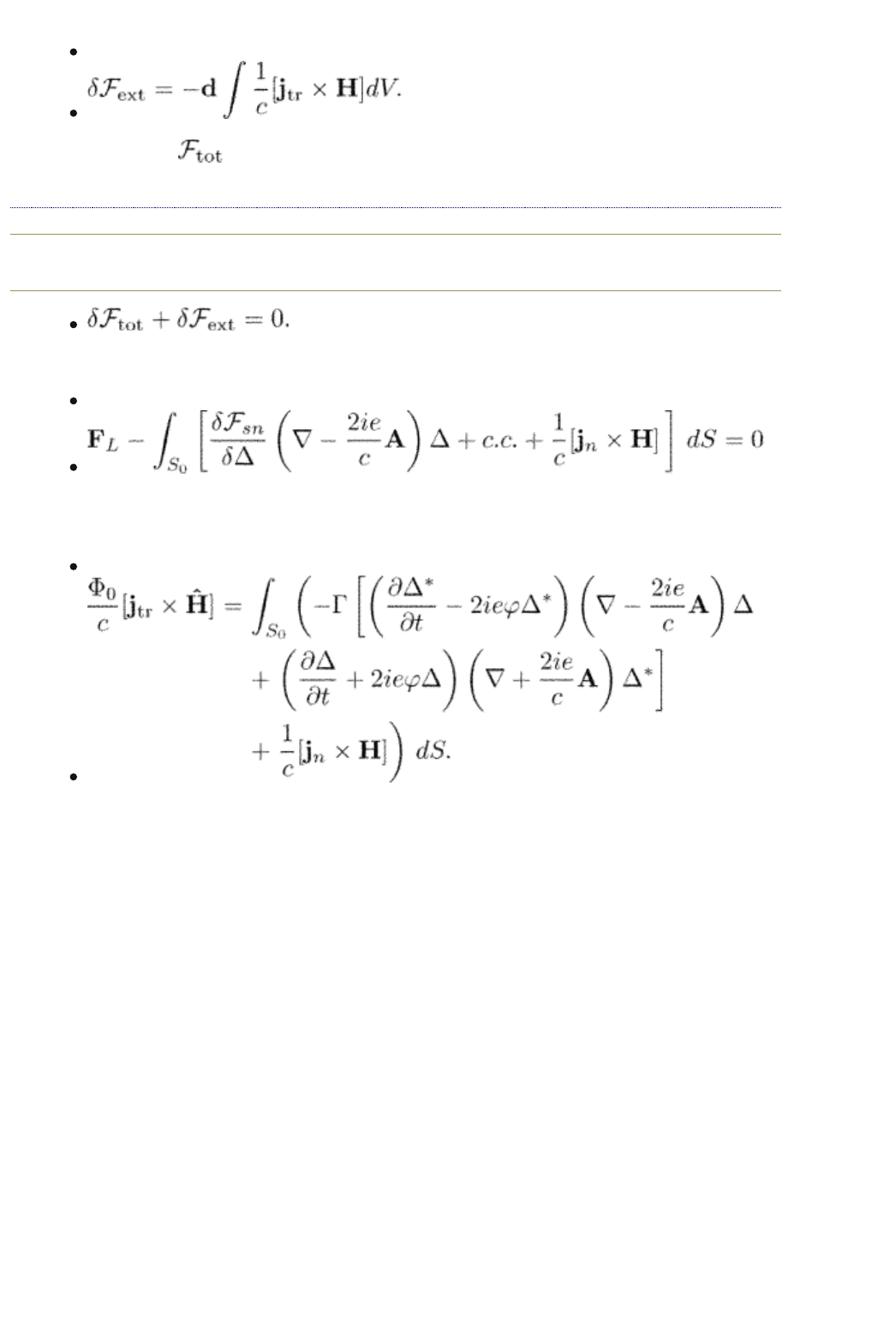
On the next step, we omit the surface term and use that divj
tr
= 0. We find
(12.14)
Conservation of plus the external energy implies its translation invariance
end p.236
It gives the balance of forces acting on a moving vortex of a unit length
(12.15)
where F
L
is the Lorentz force eqn (12.1). We use the fact that d is an arbitrary
vector. In other words,
(12.16)
Here the integration is over the unit cell of the vortex array.
To summarize, in eqns (12.12) or (12.16) the Lorentz force is balanced by the
force produced by the interaction with the environment. The latter is proportional
to the vortex velocity since the time-derivative, electric field and the scalar
potential are all proportional to v
L
.
Note that the dissipation function integrated over the unit cell can be again
obtained if we multiply eqn (12.16) with the vortex velocity v
L
:
PRINTED FROM OXFORD SCHOLARSHIP ONLINE (www.oxfordscholarship.com)
© Copyright Oxford University Press, 2003-2010. All Rights Reserved
Oxford Scholarship Online: Theory of Nonequilibrium Supe... http://www.oxfordscholarship.com/oso/private/content/phy...
第2页 共6页 2010-8-8 16:01
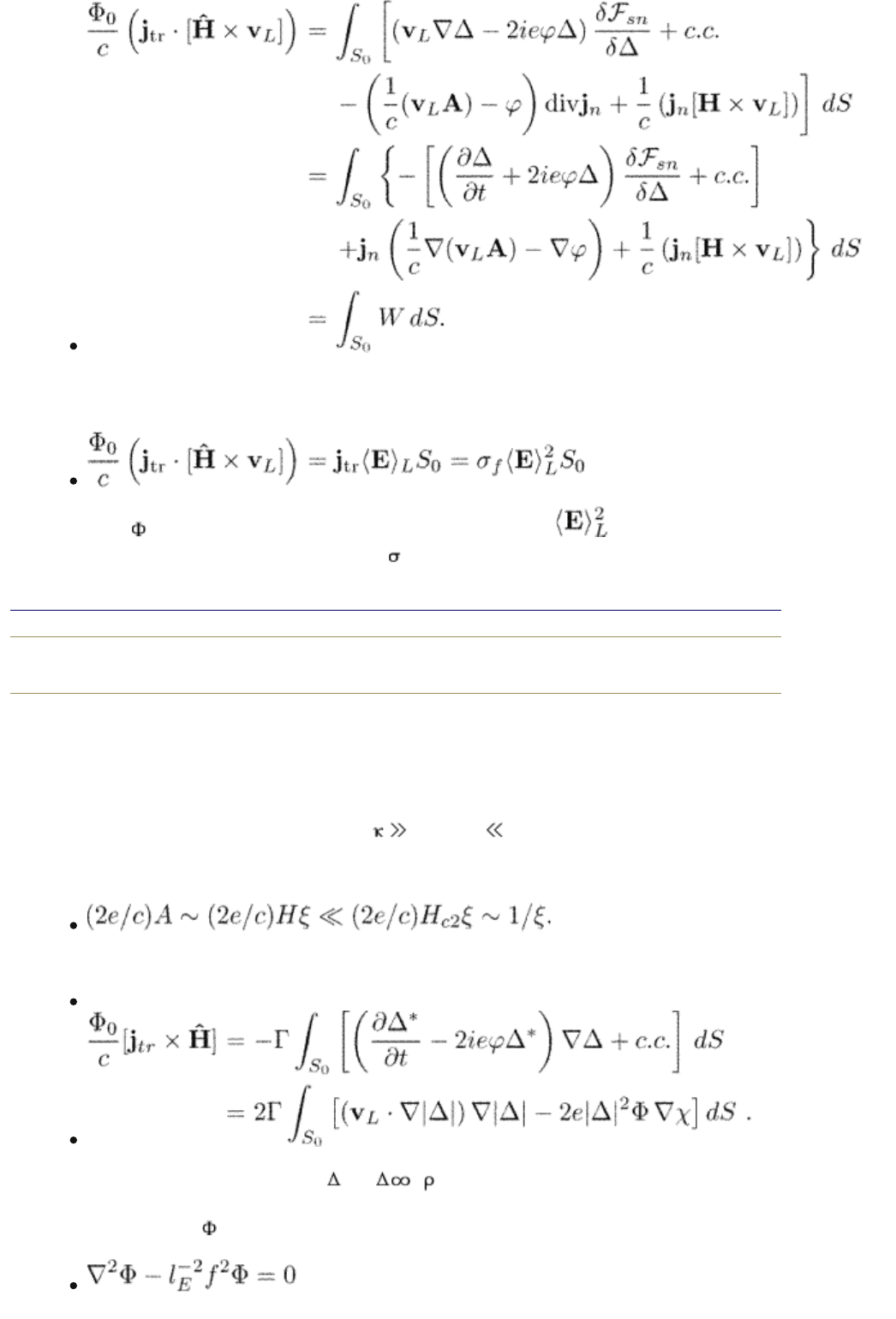
The left-hand side of this equation can be expressed through the effective flux
flow conductivity. We write
since S
0
=
0
/B. The right-hand side is also proportional to . The
coefficient of proportionality determines
f
.
end p.237
12.5 Flux flow
12.5.1 Single vortex: Low fields
Consider first a single vortex provided 1 and H H
c2
. In this case we can
neglect the magnetic field and the vector potential compared to the gradient of
the order parameter since
We have from eqn (12.15)
(12.17)
The order parameter magnitude | | = f( ) for a static vortex satisfies eqn
(1.48). To calculate the integrals in eqn (12.17) we also need to know the gauge
invariant potential
. It satisfies eqn (11.48) whence
PRINTED FROM OXFORD SCHOLARSHIP ONLINE (www.oxfordscholarship.com)
© Copyright Oxford University Press, 2003-2010. All Rights Reserved
Oxford Scholarship Online: Theory of Nonequilibrium Supe... http://www.oxfordscholarship.com/oso/private/content/phy...
第3页 共6页 2010-8-8 16:01
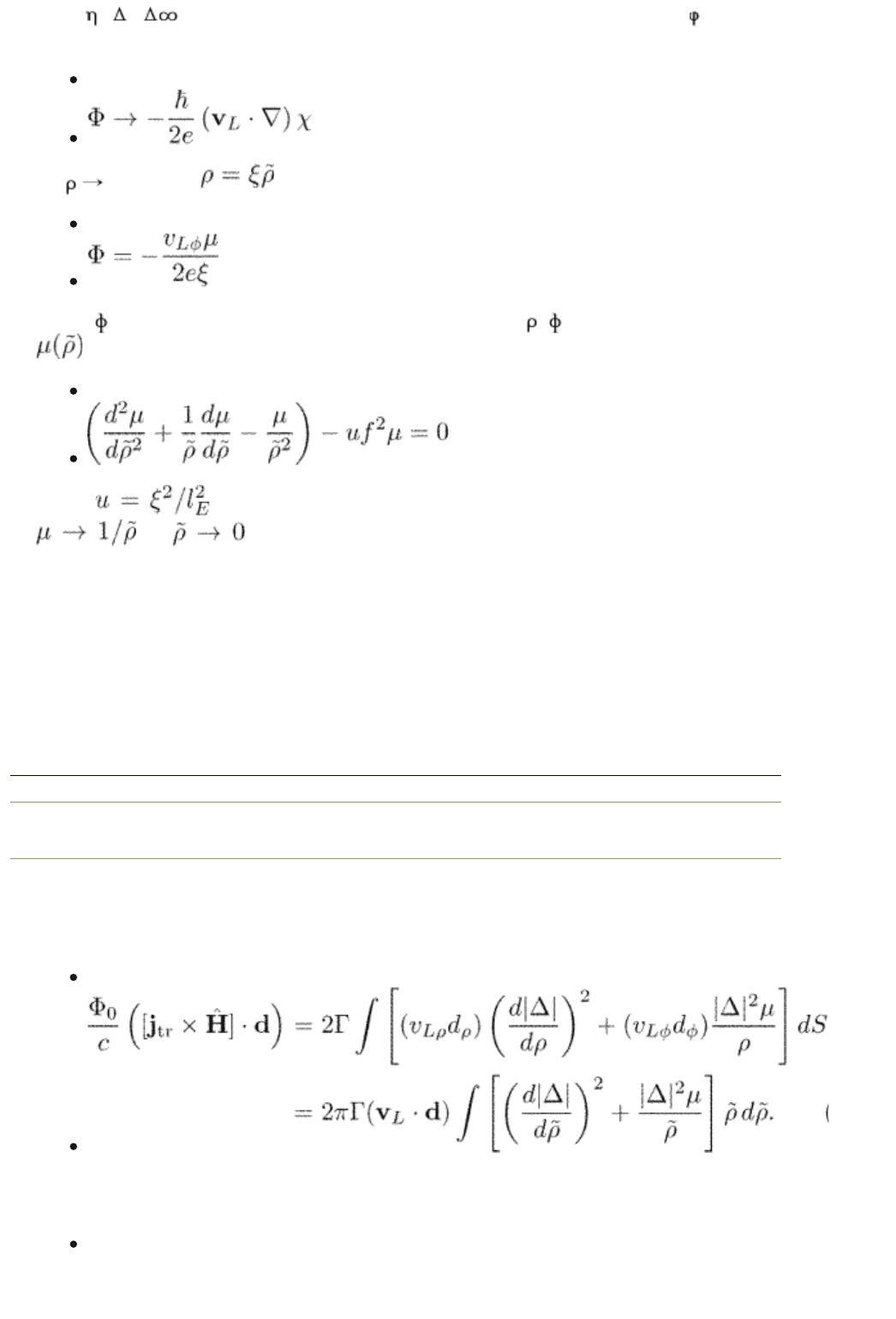
since (| |/ ) = f
2
for the usual TDGL model, eqn (1.80). The potential
should he finite. Therefore, we require
(12.18)
for 0. We put and
(12.19)
where is the azimuthal angle in the cylindrical frame ( , , z). The function
satisfies the equation
(12.20)
where , see eqn (1.81). The condition eqn (12.18) requires
for . We see that a moving vortex induces a dipole-like
scalar potential proportional to the vortex velocity.
The two terms under the integral in eqn (12.17) represent two different
mechanisms of dissipation during the vortex motion exactly as the two
corresponding terms in the dissipation function eqn (12.4). The first term is the
Tinkham’s mechanism (Tinkham 1964) of relaxation of the order parameter: Due
to the motion of a vortex, the order parameter at a given point varies in time
which produces a relaxation accompanied by dissipation. The second is the
so-called
end p.238
Bardeen and Stephen (1965) contribution. It accounts for normal currents
flowing through the vortex core.
Equation (12.17) gives
(12.21)
Here we have restored the arbitrary vector d that appears in eqns (12.12) and
(12.14) to make the calculations more convenient. The transport current is
(12.22)
PRINTED FROM OXFORD SCHOLARSHIP ONLINE (www.oxfordscholarship.com)
© Copyright Oxford University Press, 2003-2010. All Rights Reserved
Oxford Scholarship Online: Theory of Nonequilibrium Supe... http://www.oxfordscholarship.com/oso/private/content/phy...
第4页 共6页 2010-8-8 16:01

Here
(12.23)
Expressing v
L
, through we obtain the flux flow conductivity
With the microscopic values of and taken for dirty superconductors, we
find
(12.24)
As already mentioned, the first term in eqn (12.23) is due to the dissipation
caused by relaxation of the order parameter after passage of a vortex, while the
second one comes from the normal-current dissipation in the vortex core. In the
TDGL model with u ~ 1, both mechanisms give comparable contributions to
f
.
The numerical calculations using the vortex order parameter obtained by solving
the GL equation give for the first term (see the review by Gor’kov and Kopnin
(1975) and references therein)
which is independent of u. The second term, however, does depend on u. For
example, for u = 5.79 we have
To calculate a
2
we need first to solve eqn (12.20). In this case, the total
coefficient is a
0.502. The flux flow conductivity becomes
end p.239
(12.25)
It is close to t ho expression
f
=
n
H
c2
/B known as the Bardeen–Stephen model
(Bardeen and Stephen 1965). This simple prediction implies that the flux flow
resistivity is just a normal-state resistivity times the fraction of space occupied by
PRINTED FROM OXFORD SCHOLARSHIP ONLINE (www.oxfordscholarship.com)
© Copyright Oxford University Press, 2003-2010. All Rights Reserved
Oxford Scholarship Online: Theory of Nonequilibrium Supe... http://www.oxfordscholarship.com/oso/private/content/phy...
第5页 共6页 2010-8-8 16:01
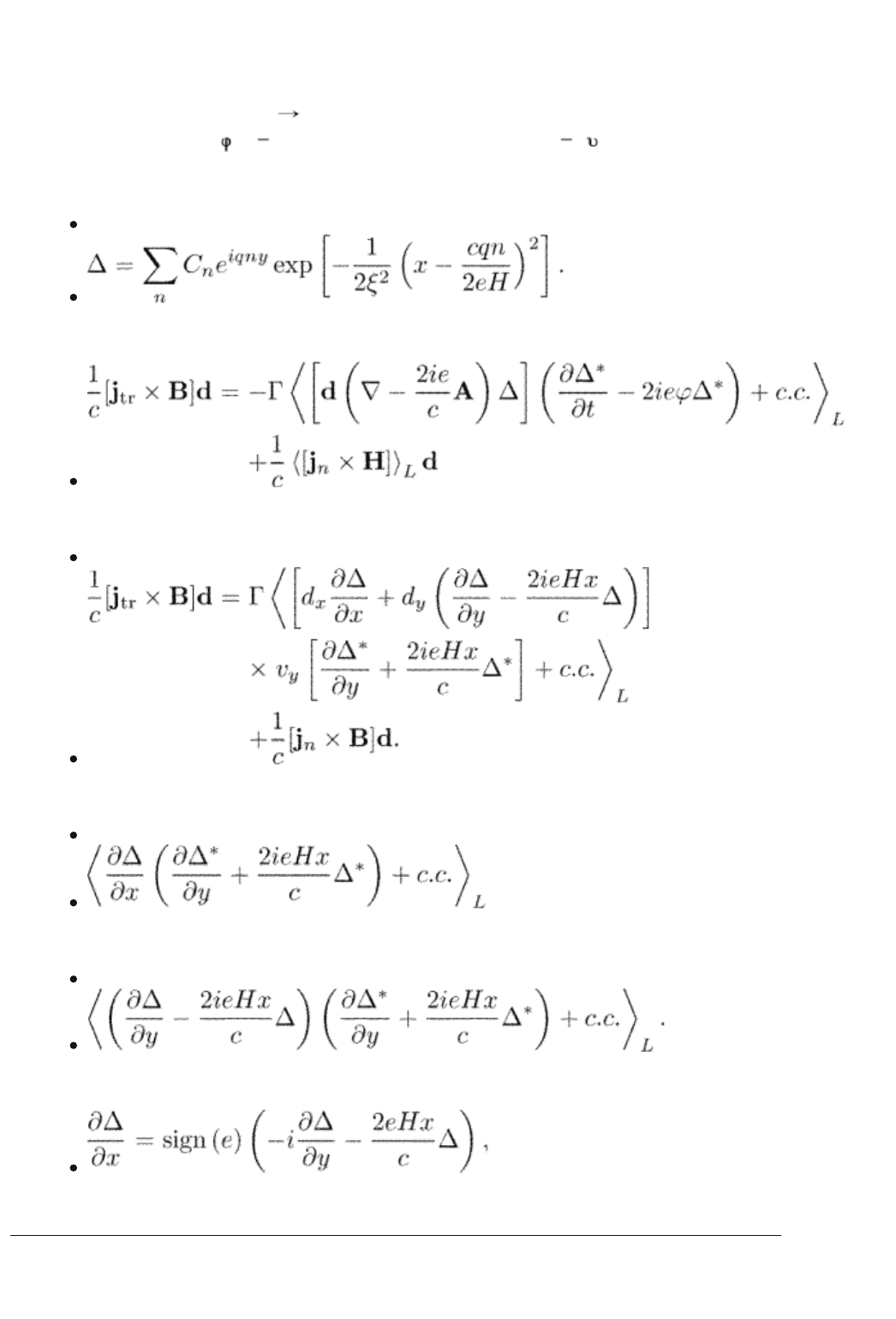
vortex cores.
12.5.2 Dense lattice: High fields
Consider now high fields, H H
c2
. We put A = (0, Hx, 0), and choose the static
potential in the form
= E
x
x, where the electric field E
x
= (
y
/c)H is
homogeneous in the leading approximation. Recall that the static order
parameter in the vicinity of the upper critical field, see Section 1.1.2, eqn (1.36):
(12.26)
Equation (12.16) gives
where d is again an arbitrary vector. We have
(12.27)
We need to calculate the averages
(12.28)
and
(12.29)
We make use of the identities
end p.240
Top
Privacy Policy and Legal Notice © Oxford University Press, 2003-2010. All rights reserved.
Oxford Scholarship Online: Theory of Nonequilibrium Supe... http://www.oxfordscholarship.com/oso/private/content/phy...
第6页 共6页 2010-8-8 16:01
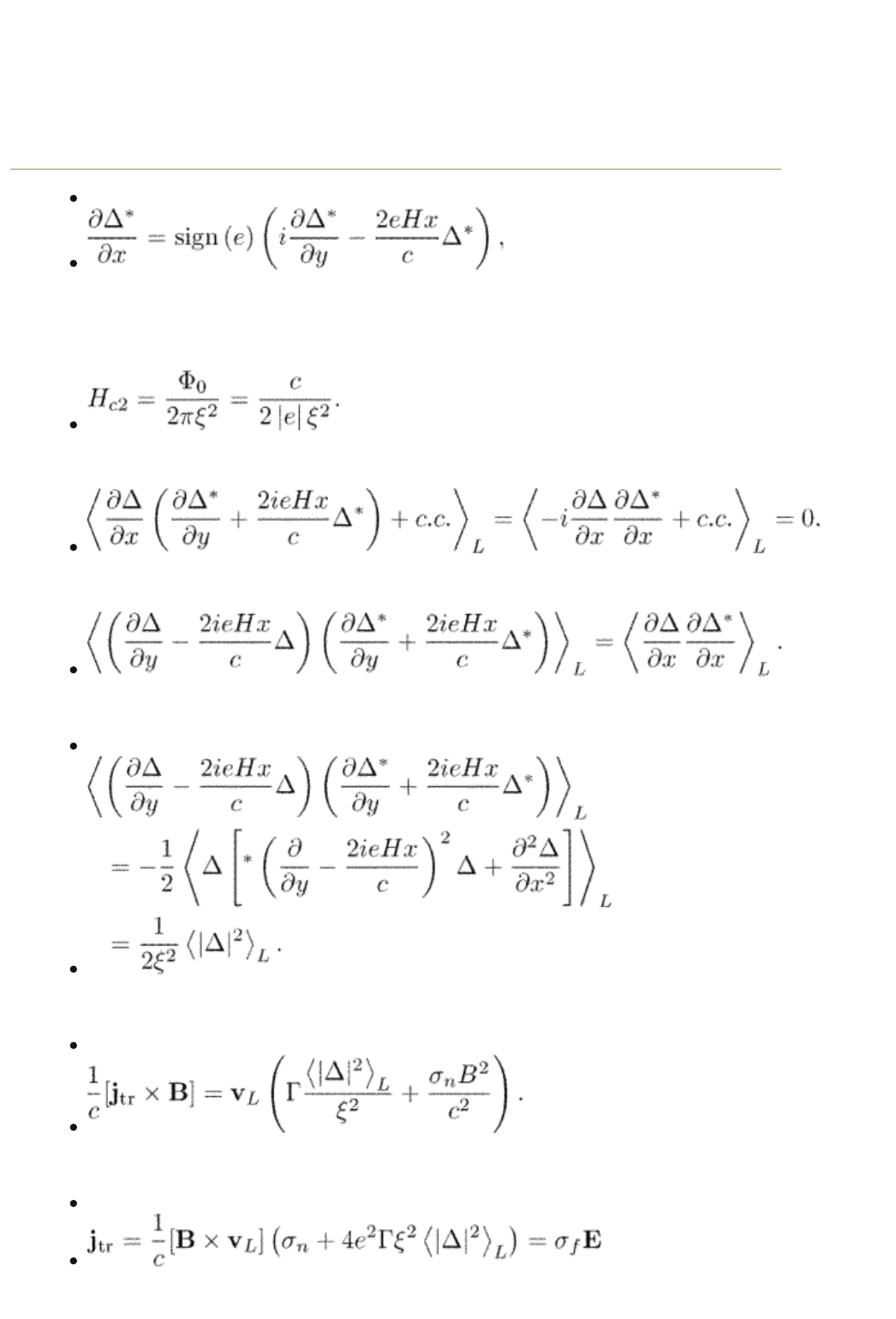
(12.30)
derived for the order parameter from eqn (12.26). The sign of the electronic
charge appears because the upper critical field contains the modulus of the
electronic charge,
For the average in eqn (12.28) we obtain
The second average is
Therefore
(12.31)
We obtain from eqn (12.27)
(12.32)
Finally
(12.33)
Kopnin, Nikolai, Senior Scientist, Low Temperature Laboratory, Helsinki University of
Technology, and L.D. Landau Institute for Theoretical Physics, Moscow
Theory of Nonequilibrium Superconductivity
Print ISBN 9780198507888, 2001
pp. [241]-[245]
Oxford Scholarship Online: Theory of Nonequilibrium Supe... http://www.oxfordscholarship.com/oso/private/content/phy...
第1页 共6页 2010-8-8 16:02
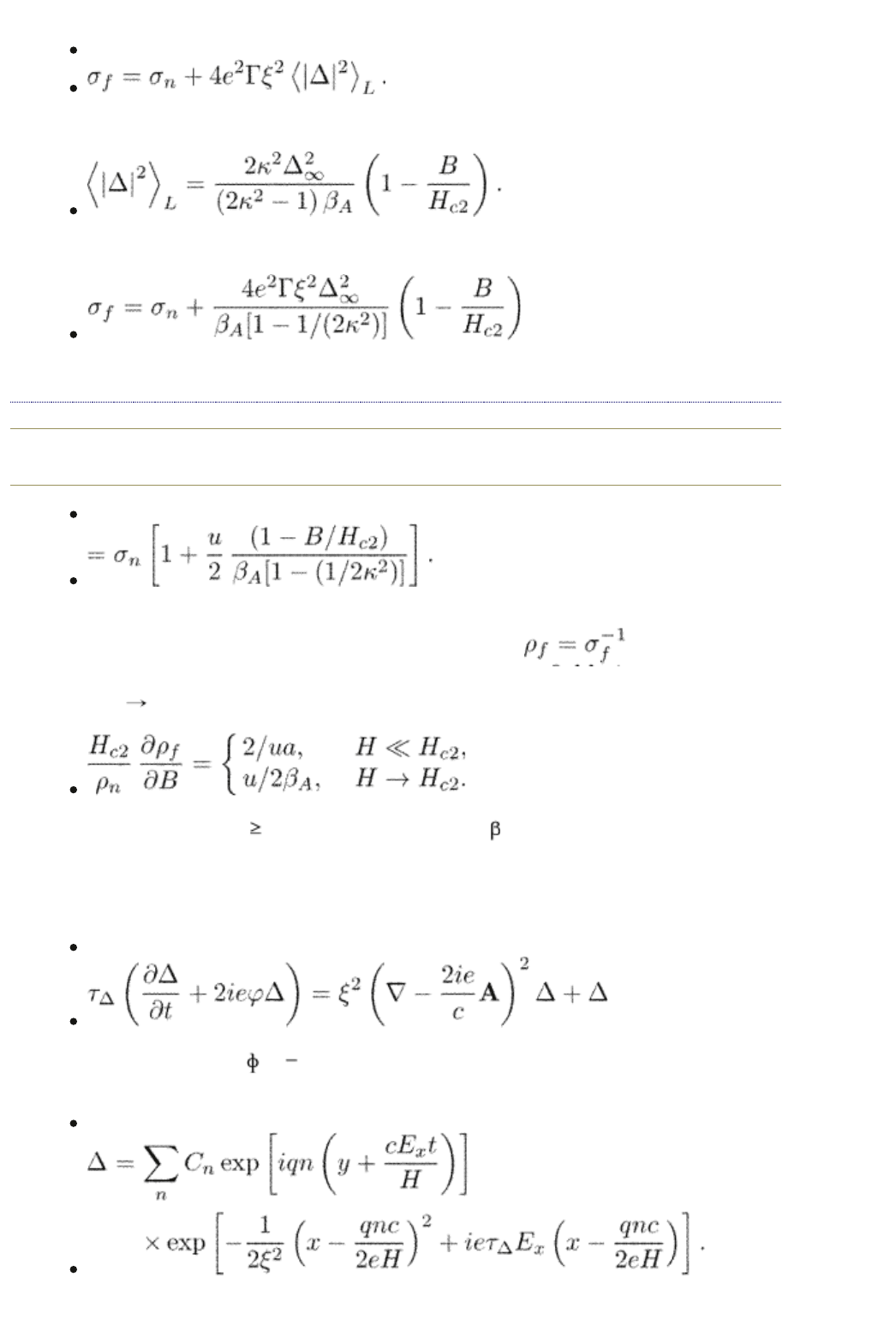
where the flux flow conductivity is
(12.34)
The average magnitude of the order parameter is from eqn (1.43)
Therefore
end p.241
(12.35)
Equations (12.25) and (12.35) determine the flux flow conductivity in the limits
of low and high magnetic fields. The effective resistivity
is linear in
the magnetic field in both limits. However, the slope at low fields is smaller than
that for H
H
c2
. Indeed,
For practical values of u 5.79, one has 2/ua < u/2
A
.
It is interesting to note that the linearized TDGL equation has an analytical
solution describing the moving vortex lattice (Schmid 1966). Indeed, the TDGL
equation
(12.36)
with A = (0, Hx, 0) and = E
x
x has the solution within the first-order terms in
E
(12.37)
PRINTED FROM OXFORD SCHOLARSHIP ONLINE (www.oxfordscholarship.com)
© Copyright Oxford University Press, 2003-2010. All Rights Reserved
Oxford Scholarship Online: Theory of Nonequilibrium Supe... http://www.oxfordscholarship.com/oso/private/content/phy...
第2页 共6页 2010-8-8 16:02
